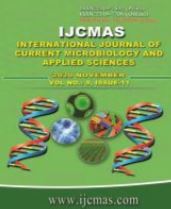


 National Academy of Agricultural Sciences (NAAS)
National Academy of Agricultural Sciences (NAAS)

|
PRINT ISSN : 2319-7692
Online ISSN : 2319-7706 Issues : 12 per year Publisher : Excellent Publishers Email : editorijcmas@gmail.com / submit@ijcmas.com Editor-in-chief: Dr.M.Prakash Index Copernicus ICV 2018: 95.39 NAAS RATING 2020: 5.38 |
A study was conducted during rabi season of 2017-18 at Agronomy Research Area of CCS Haryana Agricultural University, Hisar to study the effects of different sources and levels of nitrogen application on nutrient content and uptake of wheat. The soil of the experimental field was sandy loam in texture, neutral in reaction, low in organic carbon and available nitrogen, medium in available potassium and high in available potassium .The experiment was laid out in a split plot design with four nitrogen sources [Ordinary Urea (½ Basal and ½ at first irrigation), Ordinary Urea (½ Basal + ¼ first irrigation + ¼ heading), Neem Coated Urea (½ Basal + ½ first irrigation) and Neem Coated Urea (½ Basal + ¼ first irrigation + ¼ heading)] in main plots and four nitrogen levels (80%, 90 %, 100 % RDN and 110 % RDN) in sub plots replicated thrice. Overall results depicted that application of three split application of neem coated urea (½ Basal + ¼ first irrigation + ¼ heading)] recorded significantly higher N and K content in grain and N content in straw of wheat. Higher N uptake in grain, straw, total N, P and K uptake and K uptake by straw was also recorded with three split application of neem coated urea. However P content and uptake in grain and straw of wheat and K content in straw and K uptake in grain were not influenced significantly by varying nitrogen sources. Increasing nitrogen levels from 80 to 110 % RDN resulted in significantly higher N content in grain and straw and also higher N uptake in grain, straw and total N uptake of wheat. Similarly P and K content in grain and P uptake by grain and total P uptake of wheat increases significantly with increasing levels of nitrogen from 80 to 110 % RDN. There was no significant influence of various nitrogen levels on P content and uptake by straw, K content in straw and K uptake by grain of wheat. There was no significant difference due to application of various N levels and sources on N, P and K status of soil after harvesting of wheat.
 |
 |
 |
 |
 |